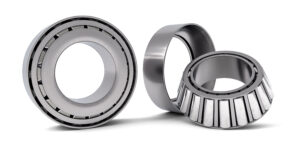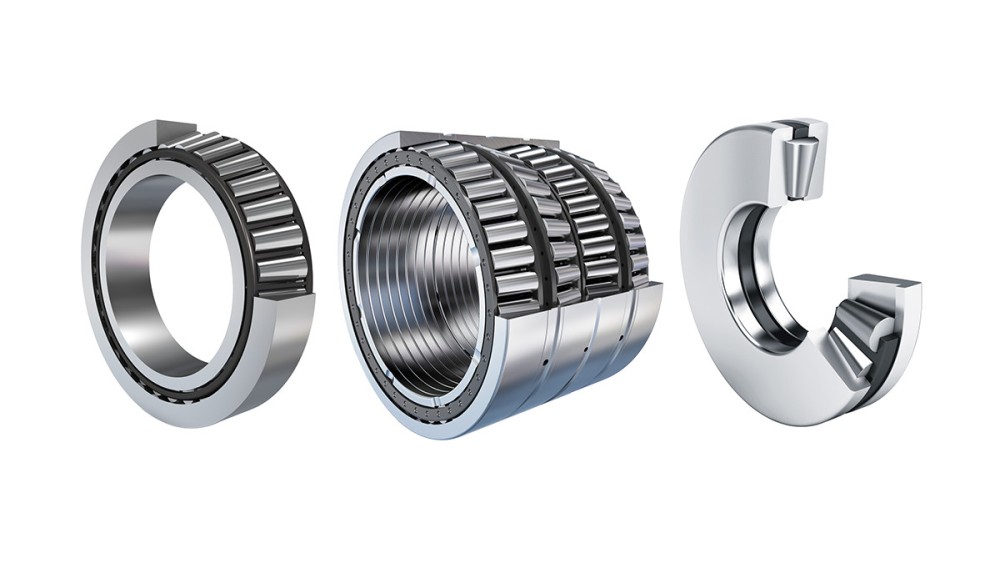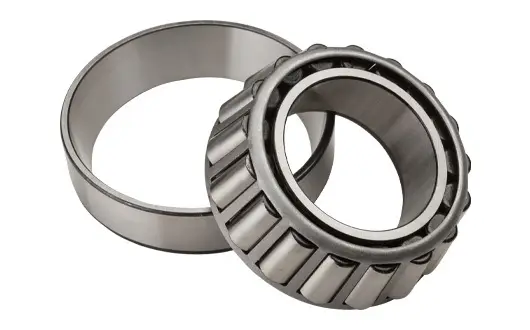
Can you Explain the Design and Construction of Tapered Roller Bearings?
The design and construction of tapered roller bearings are characterized by their conical geometry and specific components that enable them to handle radial and axial loads simultaneously. Here’s an overview of their design and construction:
- Components:
Tapered roller bearings consist of the following components:
- Inner Ring:
The inner ring has a conical raceway on its inner surface, which matches the conical shape of the rollers. It serves as the raceway for the rollers and provides support to the rotating assembly.
- Outer Ring:
The outer ring also features a conical raceway on its inner surface that complements the shape of the rollers. The outer ring provides a rigid structure to house the entire bearing assembly.
- Tapered Rollers:
The rollers have a conical shape with varying diameters along their length. This design allows the rollers to make point contact with the inner and outer raceways, distributing loads efficiently.
- Cage:
The cage or retainer holds the rollers in position, maintaining proper spacing and preventing them from coming into contact with each other. The cage material can vary, and its design may affect factors like friction and heat generation.
- Conical Geometry:
The distinguishing feature of tapered roller bearings is their conical geometry. The conical angle is defined by the contact angle between the roller axis and the bearing axis. This angle facilitates effective load distribution and axial load support.
- Load Distribution:
The conical shape of the rollers and raceways allows tapered roller bearings to handle both radial and axial loads. Radial loads are primarily supported by the larger diameter of the rollers at the large end of the cone, while axial loads are absorbed by the smaller diameter near the small end of the cone.
- Adjustable Clearance and Preload:
Many tapered roller bearings allow for adjustable internal clearance or preload. This feature enables fine-tuning of the bearing’s internal play, optimizing performance and minimizing friction.
- Thrust Capability:
Tapered roller bearings can handle thrust (axial) loads in one direction, making them suitable for applications where axial loads need to be managed along with radial loads.
- Applications:
Tapered roller bearings find applications in various industries, including automotive, heavy machinery, aerospace, and more. They are used in scenarios that require efficient load distribution and handling of combined loads.
In summary, tapered roller bearings are designed with conical geometry to accommodate both radial and axial loads. Their specific components, such as tapered rollers and a cage, work together to ensure effective load distribution, making them suitable for a wide range of industrial applications.

What Factors should be Considered when Selecting a Tapered Roller Bearing for a Specific Application?
Choosing the right tapered roller bearing for a specific application involves considering various factors to ensure optimal performance and reliability. Here are the key factors to consider:
- Load Requirements:
Assess the types and magnitudes of both radial and axial loads the bearing will experience. Choose a tapered roller bearing with a load capacity that comfortably exceeds the expected loads to prevent premature wear or failure.
- Speed:
Determine the required rotational speed of the bearing. High-speed applications may require bearings designed for reduced friction and heat generation to maintain efficiency and avoid overheating.
- Precision and Tolerance:
Consider the level of precision required for the application. Tapered roller bearings are available in different precision classes, such as ABEC (Annular Bearing Engineering Committee) grades, which impact factors like smoothness and accuracy of rotation.
- Mounting and Installation:
Assess the available space for mounting the bearing and consider the ease of installation. Bearings with adjustable clearance or preload might be advantageous for fine-tuning the bearing’s internal play.
- Temperature and Environment:
Take into account the operating temperature range and environmental conditions of the application. Extreme temperatures or corrosive environments may require specific bearing materials or coatings.
- Lubrication:
Choose an appropriate lubricant based on the application’s speed, temperature, and load conditions. Proper lubrication ensures smooth operation, reduces friction, and prolongs the bearing’s lifespan.
- Cost and Budget:
Consider the budget allocated for bearings. High-precision or specialized bearings may come at a higher cost, but their performance benefits can outweigh the initial investment over the bearing’s service life.
- Application Type:
Identify the specific industry and application in which the bearing will be used. Tapered roller bearings are employed in various sectors, including automotive, heavy machinery, aerospace, and more.
- Expected Lifespan:
Estimate the required bearing lifespan for the application. Factors such as load, speed, and maintenance practices can impact the bearing’s longevity.
- Bearing Size and Design:
Choose a bearing size that fits within the application’s space constraints while providing the necessary load capacity. The design, including the number and arrangement of rollers, can influence load distribution and performance.
- Maintenance Requirements:
Consider the maintenance schedule and accessibility for bearing inspection and replacement. Bearings in applications with limited maintenance intervals may require enhanced durability.
In conclusion, selecting a tapered roller bearing for a specific application involves assessing load requirements, speed, precision, mounting, temperature, lubrication, cost, application type, expected lifespan, bearing size, and maintenance considerations. Careful evaluation of these factors ensures that the chosen bearing meets the demands of the application while providing reliable performance and longevity.

What Advantages do Tapered Roller Bearings Offer Compared to Other Bearing Types?
Tapered roller bearings offer several advantages that make them a preferred choice in various applications compared to other bearing types. These advantages stem from their unique design and capabilities. Here’s a look at the benefits of tapered roller bearings:
- High Load-Carrying Capacity:
Tapered roller bearings can handle both radial and axial loads simultaneously, making them suitable for applications with combined loads. Their conical geometry allows for effective load distribution, enabling them to support heavy loads without premature wear.
- Efficient Axial Load Handling:
Tapered roller bearings excel at managing axial (thrust) loads in one direction. This capability is crucial in applications where axial loads are present, such as automotive transmissions or industrial machinery.
- Reduced Friction and Heat Generation:
The conical shape of the rollers and the matching raceways result in point contact, reducing friction and minimizing heat generation. This efficiency contributes to improved overall performance and energy savings.
- Adjustable Clearance and Preload:
Tapered roller bearings often allow for adjustable internal clearance or preload. This feature enables fine-tuning of the bearing’s play, optimizing performance and extending the bearing’s lifespan.
- High Precision:
Tapered roller bearings are available in various precision classes to meet different application requirements. Their precision makes them suitable for applications demanding accurate motion control and positioning.
- Versatility:
Tapered roller bearings are used in a wide range of industries and applications, from automotive and heavy machinery to aerospace and industrial equipment. Their ability to handle diverse loads and conditions contributes to their versatility.
- Durability:
Tapered roller bearings are designed to withstand shocks and impacts, making them suitable for applications with dynamic loads or vibrations. Their robust construction contributes to their overall durability.
- High-Speed Capability:
Tapered roller bearings can operate at high speeds due to their efficient contact geometry and reduced friction. This makes them suitable for applications requiring rapid rotation.
- Cost-Effectiveness:
While the initial cost may vary, tapered roller bearings are often cost-effective due to their long service life and ability to handle heavy loads. Their durability can lead to reduced maintenance and replacement costs over time.
- Compatibility with Combined Loads:
Tapered roller bearings are well-suited for applications where radial and axial loads occur simultaneously, eliminating the need for multiple bearing types and simplifying design and installation.
In summary, tapered roller bearings offer a combination of load-carrying capacity, efficiency, adjustability, precision, and versatility that sets them apart from other bearing types. Their ability to handle a variety of loads and conditions makes them an advantageous choice in numerous industrial applications.


editor by CX 2024-04-25